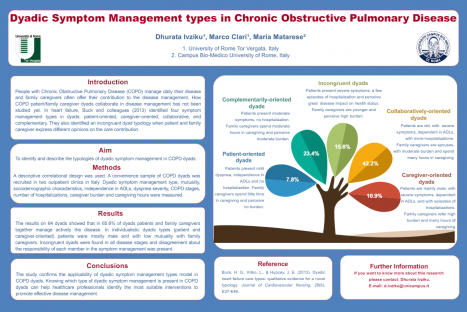Dyadic Symptom Management types in Chronic Obstructive Pulmonary Diseasein
Autori
Abstract
Introduction
Patients with Chronic Obstructive Pulmonary Disease (COPD) self-manage daily their disease and often caregivers offer their contribution to the symptoms management. How COPD patient-caregiver dyads collaborate in symptom management has not been studied yet. In heart failure, Buck and colleagues (2013) have proposed a model, which identifies four types of dyadic symptom management: patient-oriented, caregiver-oriented, collaborative, and complementary. Aim: To identify the types of dyadic symptom management in COPD and define the predictors.
Aim
To identify the types of dyadic symptom management in COPD and define the predictors.
Method
A descriptive correlational design was used. A convenience sample of COPD dyads was recruited in two outpatient clinics in Italy.
Results
The preliminary results on 64 dyads showed that 7.8% dyads were patient-oriented, 10.9% caregiver-oriented, 42.2% collaborative, 23.4% complementary, while 15.6% were incongruent in reporting their symptom management. On collaborative dyads significant correlations were found with patient’s age, comorbidity, number of medicines and smoking. An individualistic dyadic model was present when low mutuality was reported with caregivers. In a caregiver oriented dyad correlations were found with quality of life, dyspnoea severity and burden
Conclusions
The study confirms the applicability of dyadic symptom management model in COPD. Knowing which type of dyadic symptom management is present in COPD dyad helps healthcare professionals to identify the most suitable intervention to promote effective disease management.



